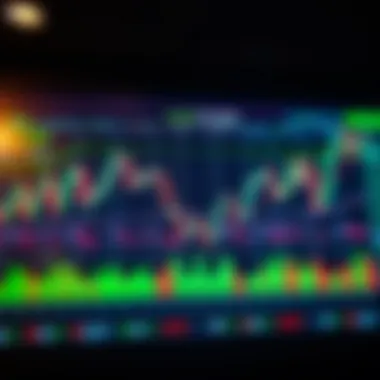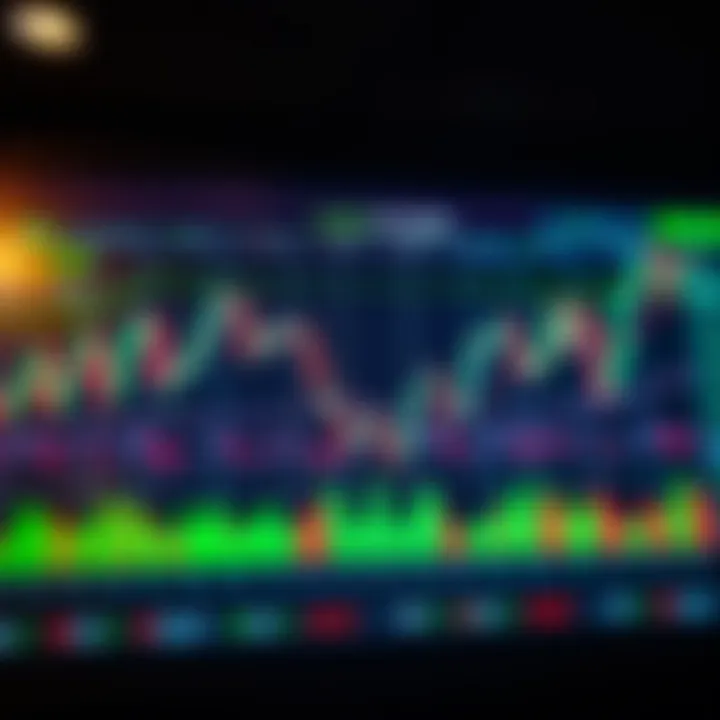Mastering Day Trading: Essential Insights and Strategies


Intro
Day trading can often feel like a roller coaster ride: thrilling, fast-paced, and, at times, overwhelmingly unpredictable. As individuals plunge into this world, they quickly discover that it takes more than just a hefty capital and a good internet connection to succeed. Understanding the intricacies and subtleties behind day trading can set the groundwork for a fruitful venture. This guide will navigate through important strategies, essential skills, and the psychological landscape that every aspiring trader should master.
Each day is a new canvas in the market, where traders paint their fortunes with the broad strokes of analysis and timing. However, it’s critical to build a solid foundation by grasping essential concepts and industry specifics. From the basics of market orders to the significance of volatility, words like 'liquidity' and 'arbitrage' become part of the daily lexicon.
In the following sections, we will delve deeper into these terms and ideas that form the backbone of day trading, making sure that both newcomers and seasoned traders have a comprehensive reference point.
Let's begin with the definition of key terms—these foundational concepts will arm you with the vocabulary and understanding necessary to navigate the fierce waters of day trading.
Understanding Day Trading
In the realm of finance, day trading stands as a beacon of opportunity—one that attracts both the seasoned veterans and wide-eyed newcomers alike. The importance of grasping the nuances of this topic cannot be overstated. At its core, understanding day trading means comprehending the rapid pace and strategic depth that define this approach to the financial markets. The stakes are high, but so are the rewards.
One vital element of day trading is its inherent structure. Day traders operate within a tight timeframe, often executing multiple trades within a single day. This professional style requires a keen understanding of market fluctuations, allowing traders to capitalize on minute price changes. The benefits of mastering day trading include the potential for significant profits, while the dangers loom large as well, underscoring the necessity for diligence and preparation.
Considered alongside traditional investing, day trading necessitates speed and agility, which in turn fosters important elements of skill development and emotional fortitude. -
"Successful day trading is not just about knowing where the market is headed, but also about having the discipline to stick to your plan when the going gets rough."
When diving deeper into the practice, the subtleties of terms, strategies, and market indicators emerge. Comprehension of day trading impacts not only a trader's approach to their trades but also their overall career longevity.
Definition and Basics of Day Trading
Day trading is the act of buying and selling financial instruments within the same trading day, aiming to take advantage of small price movements. Unlike long-term investors who may hold assets for months or years, day traders close out positions to avoid overnight risks and unlock quick profits. This is achieved through a combination of technical analysis and market sentiment, often leveraging various platforms to execute trades almost instantaneously.
For those interested in this fast-paced world, basic knowledge must include understanding trading volume, price action, and liquidity. Moreover, most day traders utilize real-time data and technical charts to inform their decision-making process, often considering factors such as ongoing market news and broader economic indicators.
Difference Between Day Trading and Other Trading Styles
Crucially, the difference between day trading and other trading styles lies in the time horizon and the approaches taken. Where day trading is focused on execution lower than a day, swing trading allows individuals to hold positions for several days or weeks to take advantage of anticipated shifts.
- Scalping: A technique closely related to day trading, scalping is centered on making numerous small profits on very tiny price changes. Traders here may focus on seconds or minutes rather than hours.
- Swing Trading: Traders are more likely to embrace medium-term market fluctuations. They rely on daily or weekly charts rather than immediate price actions.
- Position Trading: This approach involves holding trades for longer periods—weeks or even months—capitalizing on significant price movements. Here, fundamental analysis plays a more prominent role than it does for day traders.
In summary, while all these styles operate under the umbrella of trading, day trading is distinguished by its urgency and simplicity towards daily returns.
The Skill Set Required
In the fast-paced world of day trading, possessing the right skill set can significantly dictate whether one finds success or struggles. While many may think that experience alone dictates success, it's actually a blend of specific skills that create the foundation for a fruitful trading career. This section strives to underscore those essential capabilities that aspiring day traders must cultivate. Each of these skills not only enhances trading performance but also builds resilience against common pitfalls that tend to ensnare the unwary.
Analytical Skills
Analytical skills are foundational to any trader’s toolkit. They allow you to decipher trends, identify viable opportunities, and make informed decisions. The ability to analyze data effectively enables traders to spot patterns that could indicate future movements in the market.
A keen analytical mind can make a vast difference. For example, if you notice a consistent rise in a stock’s price following positive quarterly reports, you can predict potential gains. Furthermore, studying past price movements alongside current market conditions can lead to insights that others might overlook.
"Without analysis, trading is just guessing."
To sharpen these skills, consider the following:
- Practice Regularly: Engage in mock trading sessions to analyze trends.
- Study Historical Data: Understand how historical events influenced market changes.
- Use Analytical Software: Familiarize yourself with tools that can aid in the analysis.
Analytical skills are imperative, pushing one to think critically and utilize a strategic mindset rather than leaving decisions to chance.
Risk Management Techniques
Effective risk management is like a safety net for day traders. In a realm where market movements can flip scenarios in an instant, mitigating potential losses becomes paramount. Ratio analysis, for instance, allows traders to determine the maximum loss they're willing to accept on a given trade, thus preventing risk from spiraling out of control.
Key components of risk management include:
- Setting Stop-Loss Orders: This mechanism closes a trade when it reaches a predetermined loss limit, shielding you from further downside.
- Utilizing Position Sizing: Adjusting the size of your trades based on your account balance helps ensure that no single loss can decimate your trading capital.
- Diversifying Selections: Spreading investments across various sectors can reduce the impact of unfavorable movements in any one stock.
The ultimate goal of risk management is to preserve capital while still allowing room for growth. It's about striking that fine balance between risk and reward.
Technical Analysis Proficiency
A successful day trader must be proficient in technical analysis, which involves evaluating statistical trends gathered from trading activity. Mastery of this skill can transform your trading into a well-guided journey, enabling you to interpret chart signals accurately.
Commonly used tools that day traders often rely upon include:
- Chart Patterns: Recognizing patterns like head and shoulders or triangles can provide insights on potential future price movements.
- Indicators: Familiarity with indicators such as Moving Averages and the Relative Strength Index (RSI) can be invaluable.For instance, a trader may decide to buy a stock if its price crosses above the moving average, suggesting a change in momentum. Proficiency in these areas helps traders not just react but predict market movements effectively.
Emotional Discipline
Day trading is as much about psychology as it is about market knowledge. Emotional discipline permits a trader to maintain composure even in tumultuous market conditions. Without it, fear and greed can derail even the best-laid plans, leading to impulsive decisions that often end in losses.
Practicing emotional discipline can involve:
- Setting Personal Rules: Establish guidelines governing your trading behavior to prevent emotional reactions from clouding judgment.
- Routine Self-Assessment: Regularly reflect on past trades to identify emotional influences behind decisions, both good and bad.
- Mindfulness Techniques: Incorporating practices such as meditation can help maintain focus amid high-pressure trading environments.
Developing emotional discipline is not merely an add-on skill but essential for sustainable success. Traders who master their emotions are the ones who thrive, weathering the ups and downs of daily trading.
Market Analysis for Day Traders
Market analysis stands at the very core of day trading. Without a solid understanding of the market, traders essentially sail in uncharted waters. Insights gained from thorough market analysis equip traders with the foresight to seize profitable opportunities while navigating potential pitfalls. As such, it’s imperative that aspiring and experienced day traders alike invest time in grasping how various market elements interplay to influence dynamics and movements throughout the day.
Understanding Market Trends
One of the first steps in effective market analysis is recognizing market trends. These trends help traders identify the general direction—a sustained upward or downward inclination—of a security over a particular period. Knowledge of such trends allows traders to anticipate future movements.
A few key pointers to keep in mind are:
- Types of Trends: Generally categorized into upward, downward, and sideways trends, each trend type serves a different purpose for traders.
- Trend Duration: Short-term trends can provide immediate trading opportunities, while long-term trends are crucial for strategic planning.
- Momentum: Understanding momentum gives traders insight into how strong a trend is. Strong momentum might signify that a trend is likely to continue, while weakening momentum can trigger concerns about reversals.


Harnessing the knowledge of market trends enables traders to make informed decisions swiftly and efficiently.
Using Technical Indicators
Technical indicators offer day traders a quantitative framework through which they can gauge potential price movements. Here, we'll explore some of the staples in the arsenal of day traders.
Moving Averages
Moving averages are ideal for tracking the average price over a given timeframe. Their primary role lies in smoothing out price fluctuations, making it easier to spot trends. One key characteristic of moving averages is their ability to minimize noise, enhancing clarity for traders. The two most common forms are the Simple Moving Average (SMA) and the Exponential Moving Average (EMA).
- Benefits: They are widely regarded for their straightforward application and effectiveness in identifying support and resistance levels.
- Considerations: However, it’s essential to note that moving averages lag behind market prices since they are based on past data, potentially leading to delays in decision-making.
Relative Strength Index
The Relative Strength Index (RSI) is a momentum oscillator that measures the speed and change of price movements. Typically used on a scale from 0 to 100, it assists traders in identifying whether an asset is overbought or oversold.
- Characteristic: The RSI's beauty is its dual role as a trend predictor and a signal for potential reversals.
- Utility: By flagging overbought conditions (above 70) or oversold conditions (below 30), traders gain instant insight into potential price corrections.
- Caveats: That said, like all indicators, the RSI can generate false signals, especially during strong trends when it may remain overbought or oversold for extended periods, leading to challenges in decision-making.
Bollinger Bands
Bollinger Bands consist of a central moving average band and two outer bands that indicate volatility at any given time. These bands adjust dynamically and compress during low volatility and expand as the market becomes more volatile.
- Key Feature: Traders often use them to gauge whether prices are high or low on a relative basis.
- Advantage: Bollinger Bands can highlight potential breakout opportunities when prices push beyond the upper or lower band, signaling a movement.
- Consideration: However, a trader should remain cautious, as false breakouts can occur, leading to potential losses. Hence, integration with other indicators often proves effective.
Reading Candlestick Patterns
Candlestick patterns provide traders with visual cues about market sentiment at a glance. Each candlestick displays the open, high, low, and close prices within a specified time frame. Thus, these patterns can indicate potential reversals or continuations of trends.
Familiarity with popular patterns like the engulfing, hammer, or doji patterns allows day traders to gauge market psychology and sentiment efficiently. Interpretations of these formations require practice, as context matters significantly. For instance:
- How are these patterns viewed in relation to existing trends?
- What volume accompanies these formations?
In sum, understanding market analysis and its various components goes beyond mere chart reading; it requires a keen awareness of overall economic conditions, trader psychology, and external influences.
"Market analysis is like the compass for day traders; it provides direction in an often unpredictable world."
For optimal results, integrating these insights into daily trading strategies can sharpen decision-making skills, ultimately enhancing success rates.
Creating a Day Trading Strategy
Creating a robust day trading strategy is essential for anyone looking to succeed in fast-paced trading environments. Without a well-thought-out plan, you might as well be throwing darts at a board, hoping for something to land. A well-crafted strategy serves as your roadmap, guiding your trades and decision-making processes. It encompasses not just rules for buying and selling, but also clearly defined goals and rigorous risk management techniques. Essentially, having a strategy can mean the difference between navigating through the choppy waters of the market and capsizing unexpectedly.
Setting Clear Goals
Setting clear goals is your first step in constructing an effective day trading strategy. These goals should be specific, measurable, attainable, relevant, and time-bound (SMART). For instance, you might decide that you want to increase your trading account balance by 15% over a quarter. Alternatively, a goal could be to achieve a certain win rate on trades—like aiming for 60% profitability. Knowing precisely what you want lays down a solid foundation for your strategy.
It's important to regularly review these goals. You might find that what was realistic a month ago changes as your skills and market understanding improve.
Identifying Suitable Markets
Not every market is created equal, especially when it comes to day trading. You need to identify which markets fit best with your strategy and risk appetite. Some traders thrive in the forex market, while others may find success in commodities or tech stocks. Each market has its unique characteristics, including volatility, liquidity, and trading hours.
For example, stock indices like the NASDAQ or S&P 500 provide high liquidity but can also experience substantial volatility, presenting potential for quick gains or losses. Conversely, currency pairs might offer safer options but can lack the necessary price swings for day trading strategies. Doing your homework on various markets is critical in minimizing your risks and maximizing potential profits.
Developing Entry and Exit Strategies
After setting your goals and identifying suitable markets, the next step is to map out your entry and exit strategies. An entry strategy specifies when you will buy an asset based on market conditions or technical indicators, such as breakouts and retracements. Similarly, your exit strategy needs to define the conditions for selling, whether it's hitting a profit target or reaching a stop-loss level.
For instance, you might decide to enter a trade when a stock breaks above its 50-day moving average, signaling a potential upward trend. On the flip side, your exit strategy could entail selling the stock if it drops 2% below your purchase price as a loss prevention tactic. These strategies can help minimize emotional decisions when you're facing real-time market pressures.
Backtesting Your Strategy
Backtesting is a method to validate your strategy by applying it to historical data. This process can highlight how effective your strategy may be without risking real money. It’s your opportunity to identify potential flaws and adapt your approach accordingly.
Using trading platforms like ThinkOrSwim or MetaTrader, you can easily input your entry and exit rules to see how they would have performed in past market conditions. Just remember, while backtesting provides invaluable insights, it does not guarantee future results. As market conditions change, so must your strategies.
Create a documented log of your findings during backtesting. This will serve as a reference for improving your approach over time. Notably:
"A strategy that works today may not be effective tomorrow. Constant adaptation is key."
By dedicating time to these crucial components of your day trading strategy, you lay a solid groundwork that can improve both your trading performance and emotional resilience in a high-pressure environment. The right strategy is not just about financial success; it’s about forming habits that lead to sustainable growth.
Technology and Tools for Day Traders
In the fast-paced world of day trading, having the right technology and tools at your disposal can make all the difference between success and failure. As the adage goes, "failure to prepare is preparing to fail." This statement rings particularly true in trading, where split-second decisions can yield substantial profits or devastating losses. The integration of advanced tools helps traders analyze data more effectively, manage risks, and execute trades swiftly. Understanding and utilizing these tools is crucial for building a sustainable day trading career.
Choosing the Right Trading Platform
The choice of a trading platform can impact everything from execution speed to the user experience. When picking a platform, traders should consider factors like ease of use, fees, and available features. A robust platform can offer various functionalities, such as advanced charting capabilities, real-time data, and direct market access. Simplicity is key; if a platform is too complex, it can lead to mistakes. Platforms like Thinkorswim or MetaTrader are highly regarded for their comprehensive tools, but what works for one trader may not fit another.
A trader's individual strategy must align with the platform’s strengths. For example, a scalper might prefer platforms that guarantee quick order execution, while a swing trader might prioritize in-depth analysis tools. Ultimately, testing different platforms using demo accounts may help determine which one comes out on top.
Essential Software and Tools
Effective day trading relies on a suite of software tools that can help streamline the trading process. Here’s a look at some essentials:
Charting Software
Charting software is pivotal in visualizing market movements and trends. It provides real-time price data, historical charts, and various indicators that traders can use for analysis. One key characteristic of charting software is its ability to customize displays according to individual preferences. Traders can set up indicators like moving averages, Bollinger Bands, or Fibonacci retracements to reflect their trading style, making it an indispensable tool.
A popular choice among traders is TradingView, noted for its user-friendly interface and extensive indicator choices. One unique feature is its social aspect: traders can share premium insights and charts with a community, fostering an environment of learning and collaboration. However, some traders may find the variety of options overwhelming, requiring a steep learning curve initially.
Market Scanners
Market scanners allow traders to sift through vast amounts of data quickly, identifying stocks that meet specific criteria. By inputting custom filters, traders can track items like volume surges, price movements, or specific technical indicators. Their key characteristic is efficiency, saving traders time that could be spent analyzing manually. For instance, using a market scanner like Finviz can turn hours of work into minutes.


The unique advantage here lies in the ability to discover trading opportunities instantly, which is essential for day traders who thrive on speed. However, relying solely on scanners without conducting deeper research might lead to hasty decisions. A balanced approach—combining scanner findings with fundamental analysis—will yield better results.
Trading Simulators
Trading simulators are invaluable tools for both novice and seasoned traders. They provide a risk-free environment for practicing trading strategies without the danger of losing capital. The notable aspect of these simulators is their realistic scenarios, simulating market conditions closely. Platforms like NinjaTrader and eToro offer robust simulation experiences that closely mimic live trading environments.
A unique feature of trading simulators is that they often allow traders to experiment with various strategies while receiving instant feedback. This can influence performance; seeing backtesting results in real-time grants insights that are often hard to gauge in live trading. However, one should be mindful that emotions in a real market cannot be replicated in simulations. Good practice in simulators positively prepares traders but doesn't wholly substitute for real-world experience.
In summary, the right technology and tools significantly bolster a trader’s ability to navigate the complexities of day trading. Choosing the right platform, utilizing essential software, and making the most of trading simulators are crucial steps for anyone looking to upscale their trading game. Given the competitive landscape of trading, having a solid grasp of these elements can enhance decision-making and ultimately contribute to successful trading outcomes.
For more insights, visit Investopedia or explore forums on Reddit.
Understand that investing in the right tools is not just an expense, it's an investment in your trading future.
Risk Management in Day Trading
Risk management holds a crucial position in the toolkit of any day trader. In a field defined by rapid fluctuations and uncertainties, understanding how to minimize loss while maximizing gains is paramount. It’s not merely about making profits; it’s about protecting your capital. Implementing robust risk management strategies can be the line between a successful trading career and catastrophic losses. Good traders always say, "It’s not about how much you make, but about how much you keep."
Effective risk management encompasses various strategies and techniques aimed at controlling exposure to potential losses. Each step you take towards fortifying your trading practices can lead to improved decision-making and, subsequently, better financial outcomes. Let's delve into three critical components of risk management that are essential for day traders.
Understanding Leverage
Leverage can be a double-edged sword in day trading. It allows traders to control larger positions than their capital would normally permit, which can amplify both profits and losses. Essentially, it's like using a few dimes to move a mountain. However, while it can lead to significant gains, it can also lead you straight down the rabbit hole if you're not careful.
When employing leverage, it’s crucial to understand your own risk tolerance. Utilizing high leverage may seem appealing, but it can quickly escalate to a situation where your equity evaporates. Consider a simple example:
- Using 2x Leverage: Investing $100 can control a $200 position.
- Using 10x Leverage: Investing $100 can control a $1,000 position.
While higher leverage can lead to more significant profits, it also heightens your risk exponentially. Keeping leverage moderate and ensuring that you're fully aware of its implications can set a solid foundation for sound trading practices.
Setting Stop-Loss Orders
Stop-loss orders act as a safety net to protect your trading capital from unforeseen market moves. Essentially, they instruct your trading platform to exit a position when it hits a certain price, helping you limit your losses and maintain emotional calm during volatile market movements. Think of it as a firewall for your trading account.
Here’s how setting a stop-loss order can benefit you:
- Minimizes Losses: By setting a predetermined price, you can prevent emotional decision-making when trades don’t go as planned.
- Allows Focus on Strategy: You can execute your trading strategies confidently without constantly watching the market.
- Maintains Capital: Protecting your capital allows you to stay in the game longer and recover from setbacks.
For instance, if you buy a stock at $50 and set a stop-loss at $48, you are affirming your willingness to lose only $2 per share if the market turns south. This calculated approach can lead to sturdy trading practices and a more sustainable trading career.
Position Sizing Techniques
Position sizing is the process of determining how much of your capital to allocate to a particular trade. This strategy not only helps to manage risk but also plays a vital role in enhancing long-term profitability. It could be said that the efficacy of your trades often lies in how much skin you put in the game.
To effectively size your positions, consider the following:
- Risk Percentage: Many seasoned traders suggest risking no more than 1-2% of their total account on a single trade. If your account is worth $1,000, avoiding risking more than $10-$20 can make a significant difference in your longevity in trading.
- Volatility Assessment: Adjusting your position size based on the volatility of the asset can lead to more robust risk management. For instance, in highly volatile markets, smaller position sizes may be prudent.
- Consistency is Key: Maintaining consistent position sizes across trades reinforces discipline and helps eliminate emotional trading decisions.
By incorporating effective position sizing techniques into your day trading strategy, you naturally align yourself for long-term success, which is often the hallmark of profitable traders.
"The most important thing in trading is not how much you make, but how much you don’t lose." - Anonymous
For further reading on risk management strategies, consider exploring resources from Investopedia or DailyFX.
In summary, navigating the waters of day trading without robust risk management spells trouble. Leverage insights, articulate your stop-loss strategies, and hone your position sizing methods to carve out a path toward sustainable trading success.
The Psychological Battle of Day Trading
Day trading is not just about numbers and charts; it’s also a psychological dance. Many may think that making large profits is merely about having the best strategy or technology. However, the truth is, emotional resilience plays a significant role in a trader's success or failure. Understanding the psychological aspects can make or break a day trader's career. After all, in a high-stakes environment where swift decisions are crucial, an individual’s mindset often dictates their ultimate outcomes.
Overcoming Fear and Greed
One of the most crippling psychological challenges day traders face is grappling with fear and greed. Fear can rear its ugly head in various ways, often leading to hesitation in executing a well-thought-out trade. For instance, a trader may spot a potential opportunity but hesitate due to the fear of losing money. This paralyzing fear can prevent traders from capitalizing on favorable conditions.
On the flip side, greed can prompt impulsive decisions, driving traders to chase after trends or make reckless trades, thinking only of maximum profit. A good way to combat these conflicting emotions is to establish a trading plan rooted in logic rather than emotion. Clear criteria for entry and exit points can help traders stick to their game plans, gracefully sidestepping the seductive calls of fear and greed.
"Successful trading is 80% psychology and 20% strategy. The numbers won't matter if your mind is not in the right place."
Implementing techniques such as visualization or even mindfulness can also help in overcoming these hurdles. By picturing successful trades or reminding oneself to breathe through stressful situations, traders can develop a more balanced approach. Acknowledging that setbacks are a part of the journey further strengthens this resolve.
Maintaining Focus and Discipline
Focus and discipline in trading are akin to a lighthouse guiding ships safely to shore. The volatility of the market can easily distract traders from their established protocols. Maintaining focus means resisting the urge to act on fleeting emotions or external noise—whether it’s impulsive news headlines or the chatter of peers.
Creating a structured daily routine, including specific times for trading and analysis, contributes immensely to maintaining focus. By setting specific goals for trading sessions—like certain profit targets or the number of trades to execute—traders can manage their actions and keep their minds centered on their objectives.
Discipline is about sticking to one’s plan even when it feels counterintuitive. It might be tempting to chase losses or deviate from strategy after a bad day, but those consistent, disciplined trades often yield better results over time. Keeping a detailed trading journal serves as a compelling tool—it's not just about mechanics; it also reveals patterns in your emotional responses to wins and losses. Reflecting on past experiences can foster growth and lead to more strategic future decisions.
In summary, the psychological components of day trading are as vital as any technical analysis. A solid mental framework combined with robust trading processes will better equip you to navigate the tumultuous waters of day trading.
Legal and Regulatory Considerations
In the world of day trading, understanding the legal framework is not just a formality—it's a crucial pillar that can make or break a trader's career. Navigating this complex arena demands that traders not only grasp the rules that govern their activities but also appreciate the implications of non-compliance. Essentially, this section aims to shed light on the significance of adhering to regulations, the various legal parameters involved, and how these can impact trading practices positively.
Understanding Day Trading Regulations
Day trading regulations are enforced to maintain market integrity and protect individual investors from fraudulent practices. In the United States, the SEC (Securities and Exchange Commission) sets the groundwork, while FINRA (Financial Industry Regulatory Authority) provides additional oversight. It’s important for traders to understand several key regulations:
- Pattern Day Trader Rule: Under the SEC regulations, if you execute four or more day trades within five days in a margin account, you’re classified as a pattern day trader. This classification requires maintaining a minimum balance of $25,000 in your account.
- Registration and Licensing: Those wanting to day trade must ensure they adhere to applicable licensing agreements if engaging in trading as a professional. Whether you are an individual investor or part of a trading firm, the licensing helps safeguard your trading activities by holding you to particular standards of conduct.
- Disclosure and Transparency: Traders are often required to disclose their strategies and risks associated with their trading. Adhering to these requirements promotes transparency and helps the broader market operate smoothly.
"The regulatory landscape is not just a bunch of rules; it's there to keep traders from stepping on legal landmines that can have serious consequences."
Awareness and understanding of these regulations contribute recognized credibility. In this fast-paced trading environment, being compliant may well place traders a step ahead of those who overlook the rules, enabling a smoother journey in their trading endeavors.
Tax Implications for Day Traders


When it comes to day trading, taxes can feel like an additional hurdle, but being informed can mitigate unpleasant surprises. Each transaction carries potential tax implications that traders must recognize. Here are key tax considerations:
- Short-Term Capital Gains: Since day traders often hold stocks for no longer than a day, profits are classified as short-term capital gains, taxed at the trader's ordinary income tax rate, which can be significantly higher than long-term capital gains tax rates.
- Mark-to-Market Election: Some traders opt for this election under IRS Section 475, allowing them to treat gains and losses as ordinary income. For day traders, this can offer more straightforward tax treatment and may help offset losses against income.
- Deduction of Trading Expenses: Day traders can deduct specific expenses related to their trading as business expenses. This might include costs for educational resources, home office expenses, and software used for analysis, which can be beneficial in lowering taxable income.
Being proactive in tax planning is essential for day traders. Keeping a careful track of transactions, maintaining records of gains, losses, and expenses, is vital. Having a solid understanding of the tax landscape not only prepares traders for potential liabilities but also offers opportunities for strategic deductions that can improve net financial performance.
In summary, a keen understanding of legal and regulatory considerations is fundamental for any aspiring day trader. Knowledge of trading regulations safeguards your investment, while awareness of tax implications can enhance your financial outcomes in this competitive field. This isn't just a passing chore; it's part of the foundation for building a successful day trading career.
Establishing a Day Trading Routine
Establishing a robust day trading routine can be your secret sauce in the competitive world of financial trading. It’s not just about executing trades; there’s a plethora of behind-the-scenes work that demands your attention to cultivate success. Think of it as setting the stage before the curtain rises. By having a well-structured daily plan, you set the tone for your trading day, reduce stress, and increase productivity. When every minute counts in day trading, time management becomes paramount, making it essential for anyone looking to thrive in this arena.
A solid routine provides clarity, helps in honing your decision-making processes, and keeps a trader focused. It encourages a proactive rather than a reactive mindset. This means you’re less likely to get swept away by market volatility or the latest trending stock. Instead, by adhering to a well-crafted routine, you’ll make more deliberate, thoughtful choices in your trading activities. Moreover, a routine allows you to identify patterns over time, enabling you to refine your strategies and consistently improve your trading performance.
Creating a Daily Plan
A daily plan is the backbone of any serious day trading routine. It encompasses everything from the time you start, the markets you focus on, to the criteria you will use for trading. Here’s how to flesh out a comprehensive daily plan:
- Define Your Trading Hours: If you find that your focused and sharpest edge kicks in early in the morning or during specific market hours, prioritize those slots for trading.
- Set Measurable Goals: Whether it’s aiming for a certain percentage gain or limiting losses, clear goals can steer your trading decisions.
- Pre-Market Preparation: Spend time analyzing the pre-market trends. Note down potential stocks to watch, price-level triggers, and any critical news that may influence trading.
- Review Past Trades: Assess any trades made previously. What worked well? What didn’t? Learn from those experiences to fine-tune your strategy.
- Post-Market Reflection: Once the trading day ends, set aside some time to reflect on your performance. What emotions crept in? Did you follow your plan? Such insights build a trader’s roadmap to growth.
Staying Updated with Market News
In day trading, the tides can shift suddenly—knowing what’s causing those shifts is key. It’s imperative to stay on top of market news, which influences stock movements. Here are effective ways to remain informed:
- Curate Reliable Sources: Select trusted financial news outlets and subscribe to their alerts. This could include outlets like Bloomberg, CNBC, or Reuters. Each provides timely updates that can affect your trading decisions.
- Utilize Social Media Wisely: Platforms like Twitter can offer real-time news and trader sentiments. Follow analysts or trading communities for nuggets of information that traditional news may not cover immediately.
- Set News Alerts: Use financial market applications that allow you to set alerts for critical news events related to stocks you’re trading or watching. Being alerted can keep you a step ahead of potential market-moving news.
- Engage in Trading Forums: Participating in discussions on websites such as Reddit can expose you to contrasting viewpoints or new insights into market conditions. Groups can share trends, which might not yet be mainstream but could shape trading signals.
Being proactive in staying updated not only arms you with information but can also serve as a safeguard against unexpected market cries.
A well-established routine, anchored by a tailored daily plan and a commitment to staying informed, can transform your day trading experience from chaotic to purposeful. Ultimately, it’s the discipline you cultivate that can differentiate between blunders and breakthroughs.
Common Pitfalls in Day Trading
Understanding common pitfalls in day trading is essential for anyone stepping into this competitive arena. The vibrant world of day trading can be enticing, but without a sound strategy and awareness of potential hazards, traders can easily find themselves in a tight spot. Just like a seasoned sailor knows the treacherous waters of a stormy sea, a day trader must navigate through the challenges that could derail their success.
Overtrading and Impulsive Decisions
Overtrading is a recurring issue that can devastate a trader's account balance faster than you can say "market volatility." It's the act of making more trades than your strategy advises, often driven by impatience or the fear of missing out on a potential profit. Picture this: you're watching the markets, feeling the thrill of each upward tick, and before you know it, you place several trades back-to-back, thinking that more is better. This impulsive behavior can lead to substantial losses since trading too frequently can spike transaction costs and erode profits.
Tracking your trades is one sound way to avoid falling into this trap. Keeping a journal with details of your thought processes and results can help identify whether you were rational or just betting on a hunch. In the grand scheme, your trading strategy must prioritize quality over quantity. Focus on the well-thought-out trades that align with your analysis rather than jumping at every moving target.
Ignoring Risk Management Rules
Equally perilous is the tendency to ignore risk management rules, which serve as the lifeblood of sustainable trading. When traders shove risk management under the rug, they essentially gamble with their capital. Imagine walking through a minefield without a map; you're simply asking for trouble. Establishing ground rules, such as setting stop-loss orders or determining an appropriate position size based on your account balance, can prevent significant financial damage.
A good rule of thumb is to never risk more than 1% of your trading capital on a single trade. Use trailing stops to capitalize on favorable price movements while simultaneously protecting your profits. Adopting these measures might feel like adding constraints, but in fact, they serve to empower you by providing a clearer structure in which to operate.
"Failing to plan is planning to fail." This adage rings true in the realm of day trading, where rigid adherence to a strategy can keep traders afloat amidst tumultuous market waves.
Resources for Aspiring Day Traders
Diving into the world of day trading can be akin to learning a new language; it comes with its own set of jargon, nuances, and strategies. The road ahead may feel daunting, yet the right resources can illuminate your path and accelerate your learning curve. This section explores the best books, courses, and community support options available for aspiring day traders, each offering unique benefits and insights tailored for both novices and seasoned investors alike.
Books and Publications
Books may seem like old-school tools in a world dominated by apps and online courses, but they remain a gold mine of information. They provide in-depth knowledge, foundational theories, and case studies that online formats often gloss over. Some recommended readings include:
- "A Beginner's Guide to Day Trading Online" by Toni Turner - This book gives practical strategies and essential insights for those starting their journey.
- "Day Trading For Dummies" by Ann C. Logue - While it may carry a lighthearted title, this book dives deep into trading techniques, terminology, and psychological aspects.
- "The New Trading for a Living" by Dr. Alexander Elder - This work not only explores trading strategies but also covers the psychological and risk-management aspects crucial for day trading success.
Moreover, following market-related publications such as The Wall Street Journal and Bloomberg can keep you abreast of the latest trends and analysis, helping you to connect theoretical knowledge with real-world dynamics. Books don’t just fill your mind with knowledge but pique your curiosity, provoking a desire to learn more.
Online Courses and Workshops
Online learning offers flexibility and accessibility, making it a favored choice for many. Various platforms host courses that cater to all levels of expertise. A few noteworthy platforms include:
- Udemy - Check out courses ranging from basic day trading principles to advanced strategies. You can learn at your own pace, making it easier to digest complex concepts.
- Coursera - Offers courses in collaboration with universities, giving a more academic perspective on trading strategies and market analysis.
- BabyPips - Known for its Forex trading education, it’s also a respected resource for learning myriad trading strategies.
Participating in live workshops can also offer valuable hands-on experience. Engaging directly with instructors and fellow aspiring traders creates a collaborative atmosphere where questions can be asked, and expertise can be shared, fostering a richer learning experience.
Forums and Community Support
Finding a tribe can make all the difference when you're navigating the murky waters of day trading. Online forums, such as on Reddit or trading community websites, provide spaces where experienced traders and newcomers alike can exchange ideas and tips. Here are some benefits of joining such communities:
- Real-Time Feedback - Discussions often revolve around current market conditions, allowing you to gain insights and diverse viewpoints.
- Support and Motivation - Trading can be isolating. Engaging with others helps to alleviate the emotional stress by sharing experiences and strategies, fostering camaraderie.
- Access to Mentors - Many seasoned traders frequent these forums, offering invaluable advice and mentoring opportunities, which could be a game-changer as you build your skills.
Joining a community is essential; it's like having a lifeboat in a stormy sea.
The Future of Day Trading
The future of day trading is a continually evolving landscape influenced by rapid advancements in technology, shifting market dynamics, and the increasing accessibility of trading platforms. In this article, discussing the future is crucial, as the volatility inherent in day trading can either present formidable opportunities or daunting challenges for traders. Understanding the trajectory of day trading can empower traders to adapt, reevaluate their strategies, and ultimately thrive in this high-stakes environment.
Impact of Technology on Trading Practices
Technology is the backbone of modern trading, providing tools that can drastically alter how traders operate in the market. The introduction of algorithmic trading and artificial intelligence has transformed how trades are executed. These algorithms analyze vast amounts of data in mere seconds, identifying patterns and making decisions faster than any human could. This means that individual traders must not only be aware of their own strategies but also understand how to leverage technology to their advantage.
One significant shift has been the rise of mobile trading applications. This has opened the door for many new traders, enabling them to access the markets from anywhere at any time. Yet, it also creates a need for traders to improve their digital literacy. Being tech-savvy is more important than ever, as the ability to manipulate software tools and applications can greatly enhance a trader’s efficacy.
- High-Frequency Trading (HFT): This tactic exemplifies how technology is pushing boundaries. HFT firms execute thousands of trades within milliseconds, capitalizing on tiny price discrepancies. While this level of speed might seem out of reach, understanding its mechanics can help day traders formulate strategies that align with these fast-paced market movements.
- Data Analytics Tools: Besides algorithms, tools like interactive charting software and market scanners help traders visualize trends and make timely decisions. Familiarity with platforms like TradingView or Thinkorswim is crucial, as they provide real-time data and insights that can inform trading strategies.
The advent of blockchain technologies and cryptocurrencies has also sparked new paths for day trading enthusiasts. Digital currencies such as Bitcoin and Ethereum have surged in popularity, adding a new dimension to the trading world. However, this also brings heightened risk and market volatility. Understanding these emerging assets will be essential for traders looking to stay relevant.
"In the world of day trading, technology is your ally, but it can also be your greatest adversary if you don't know how to harness it."
Emerging Trends and Opportunities
As the trading landscape shifts, several trends are starting to emerge, presenting opportunities for both novice and seasoned traders. Keeping an eye on these trends can help traders position themselves for success in the future.
- Market Volatility: The current climate has produced increased market volatility, often resulting from global events and economic uncertainties. While this can be daunting, it also creates opportunities for traders who can react quickly and strategically to price swings.
- Rise in Retail Trading: Recent years have seen a surge in retail traders entering the market, partly due to more accessible platforms and educational resources. This influx has increased market liquidity but also competition. Traders will need to hone their skills and develop unique strategies to stand out in a crowded arena.
- Sustainable Investing: Interest in socially responsible and sustainable investing is on the rise. Traders who can identify trends in green technology and renewable energy sectors may find lucrative opportunities in the long run.
- Increased Regulation: Regulatory frameworks are expected to tighten as more individuals engage in day trading. Staying informed about the latest regulations will be essential to avoid pitfalls and ensure compliance.
Each of these trends points to the necessity for continuous learning and adaptation within the day trading field. The future will not favor those who remain stagnant; instead, it will reward those who engage with ongoing developments in the market. Traders who are proactive, informed, and adaptable are likely to navigate this complex landscape with greater ease.
In summary, the future of day trading is poised at the intersection of technology and strategy. Embracing advancements while understanding market dynamics will be crucial for any trader looking to carve out a successful path in this fast-paced arena.















